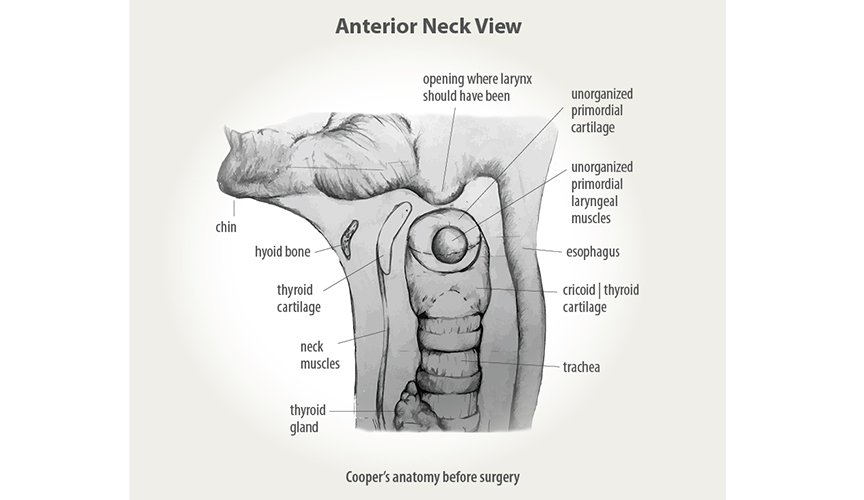Creating an Airway
Cooper Kilburn: Laryngeal agenesis
Laryngeal agenesis occurs when larynx development is halted in utero leading to no larynx or airway. The reasons for this cessation of growth are currently unknown. Children can also be born with partial laryngeal structures with the condition known as laryngeal atresia. The types of laryngeal atresia correspond with where in embryonic development the larynx growth was halted.
The facts:
- Larynx development begins in the fourth week of fetal growth. The windpipe starts as a solid tube and hollows out from the top and bottom to create an airway.
- About 50 documented cases of total laryngeal agenesis in history exist.
- Most fetuses do not survive to term due to lack of diagnosis.
- Diagnosis depends on the discovery of indirect results of laryngeal agenesis - such as Cooper's fluid-filled lungs. The lack of airway is rarely identified in fetal screenings.
- Survival depends on immediate diagnosis in utero and a rapid tracheostomy at birth.
Valcamonico, A.V., Goncalves, L.F., & Jeanty, P. (1992, August 17). Larynx, atresia, Retrieved July 16, 2019, from TheFetus.net

Creating an Airway
RIB REMOVAL
Pediatric Surgeon Ying Zhuge, MD, harvests two ribs - one from each side of Cooper's body. These ribs will be used to construct the voice box.
MODELING OF THE RIBS
While Zhuge closes the incision in Cooper's abdomen, Otolaryngologist Jerome Thompson, MD, begins shaping the ribs to be the appropriate size and shape for the front and back of the voice box.
FIRST INCISION
Thompson takes over the surgery and makes the first incisions to access the cartilage structures in Cooper's throat. He discovers a rock-hard triangular-shaped cartilage structure where the airway should be.
MARKING NEEDLES INSERTED
Because of the solid nature of the cartilage in Cooper's throat, Thompson passes a needle through the thyroid lamina, with the help of Otolaryngologist Jennifer McLevy, MD, and a video camera, to find the midline of the cartilage between Cooper’s vocal cords. He marks the space for the new airway.
POSTERIOR GRAFT PLACEMENT
After making an incision down to the esophageal muscles, Thompson inserts the first rib to form the back wall of the voice box. The first rib is secured with 20 stitches smaller than a human hair.
STENT PLACEMENT
A stent is placed in Cooper’s throat to prevent cartilage movement during the healing process. The hope is that the stent allows a mucous membrane to heal over cartilaginous walls to create a mucosalized airway. The stent remains in place for six weeks.
ANTERIOR GRAFT PLACEMENT
The final rib is put into place to form the anterior wall of the voice box. This is secured with stitches.
Help us provide the best care for kids.
Le Bonheur Children's Hospital depends on the generosity of friends like you to help us serve 250,000 children each year, regardless of their family’s ability to pay. Every gift helps us improve the lives of children.
Donate Now















